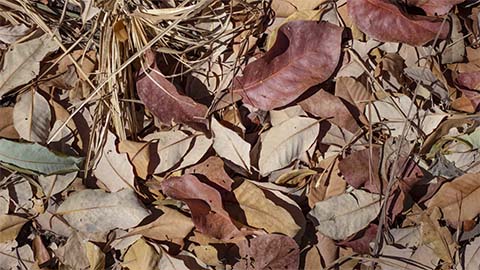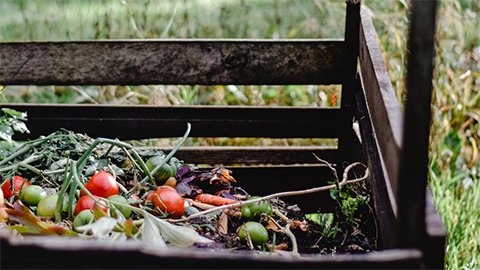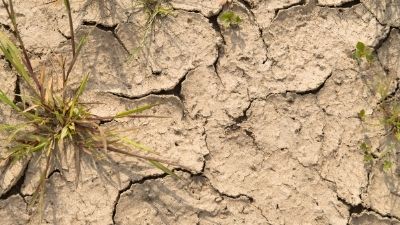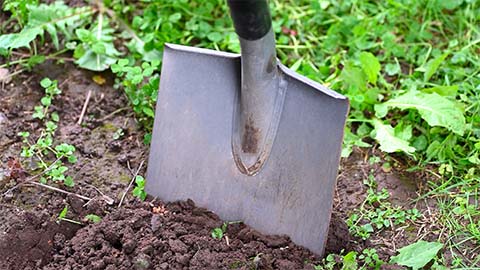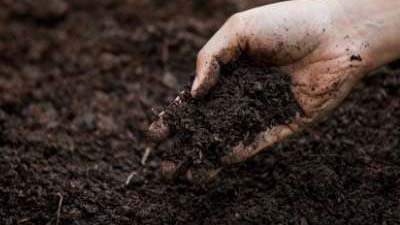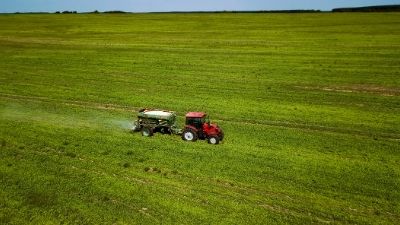Sustainable Manure and Compost Application: Garden and Micro Farm Guidelines
Applying animal manure and compost to the soil is a long-standing practice for farmers across the world. When properly managed, animal manures increase soil fertility, build soil organic matter, and sustainably cycle nutrients. However, knowing how much and when to apply manure is critical for long-term soil heath. This article provides general information on manure and compost characteristics and a step-by-step example for calculating application rates that are appropriate for gardens and micro farms (<5 acres).
Plant Nutrient Basics
There are 14 mineral nutrients that are essential for plant growth. Six of the nutrients are classified as macronutrients because plants need these nutrients in greater amounts, and eight are micronutrients because plants only need trace amounts. Plant yields will decrease if the soil does not have sufficient levels of each nutrient. The three most important macronutrients to manage are the primary macronutrients: nitrogen (N), phosphorus (P), and potassium (K). To ensure optimal plant growth, N generally needs to be added each year to non-legume crops to improve or maintain yield. P and K can accumulate in Utah soils, so it is important to regularly soil test to see if additions are needed. The secondary macronutrients are calcium (Ca), magnesium (Mg), and sulfur (S). The micronutrients are boron (B), cobalt (Co), copper (Cu), iron (Fe), chlorine (Cl), manganese (Mn), molybdenum (Mo) and zinc (Zn). Most Utah soils have sufficiently high (and sometimes excessively high) levels of secondary macronutrients and sufficient micronutrients to support healthy plant growth. Therefore, these nutrients often do not require regular soil testing or application. For more information on nutrient types, reference USU Extension Master Gardener Chapter, Fertilizers.
Manure as a Soil Builder and Nutrient Source
Manures contain most, or all, of the 14 soil-derived plant mineral nutrients, as well as organic matter. Organic matter is decomposed plant and animal tissue that will coat soil particles to give topsoil its rich, dark color. Increasing the amount of organic matter in the soil through manure or compost application can improve soil health and productivity by:
- increasing nutrients available to plants and nutrient storage in the soil,
- increasing the water available to plants and water storage in the soil,
- improving soil structure, which promotes aeration and drainage,
- supporting soil microbial communities,
- reducing compaction and surface crusting, and
- reducing erosion.
This is important in Utah, where the native soil organic matter is low (0.50 – 2%) because of the semi-arid climate. Increasing organic matter to around 5% is ideal for many soils and crops. Incorporating manure and compost into the soil is an excellent way to build soil organic matter while managing soil fertility for optimum plant growth. Manures high in undigested material or large amounts of non-sand bedding material (straw, wood shavings, etc.) will break down slowly over time and add organic matter to the soil. Solid and semi-solid manures (<75% water content) and composts contain more organic matter and are generally more effective soil builders than liquid manures and slurries (>75% water content). Manures are also readily composted because they have relatively low carbon to nitrogen (C:N) ratios that allow for quick composting. This article will focus on solid manures and composts that are most common in urban, garden, and micro farm settings.
Manure and Compost Application Drawbacks
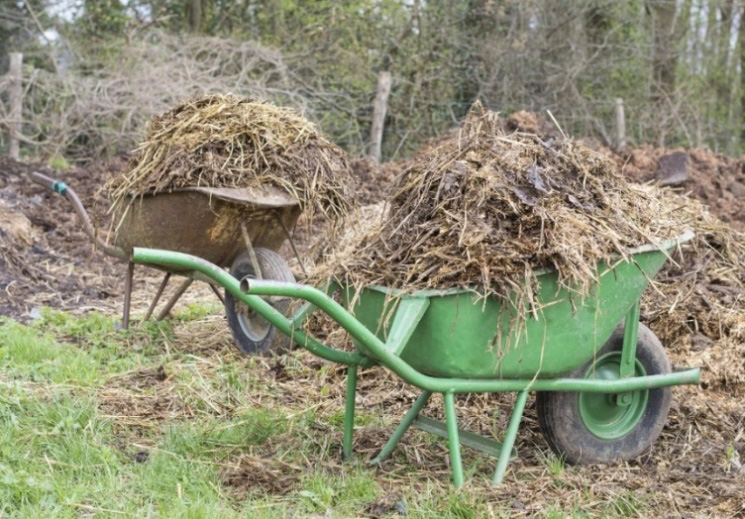
With the benefits of animal manure application, it can be tempting to apply as much manure or composted manure as possible, particularly when large volumes are available. However, over-application (large quantities or too frequent) and poorly timed applications can result in high soil salinity levels, crop burn, poor plant growth, and environmental contamination. To ensure long-term sustainability, there are key management considerations to follow that are especially important for Utah soils. In particular, manure often contains more P and K than needed by crops, but not enough N. This can lead to build up of the P and K in the soil. Too much P can reduce the plant’s ability to take up micronutrients from the soil, like Zn, but it also can become an environmental contaminant by polluting surface waters when spring runoff occurs. Too much K can increase soil salinity, which can reduce plant growth and yield. The pH and salinity of manure also tend to be greater than other soil amendments, especially manure from certain livestock like poultry (Table 1). It is important to be aware of the pH and salinity effects that come with manure application because Utah soils tend to already be alkaline (have a high pH for plant growth) and easily accumulate salt. Further increases in the soil pH and salinity through application of manures or composted manures can reduce crop yields, particularly vegetables, fruits, and cut flowers. As a general rule of thumb, these crops start to decline when soils reach a pH greater than 8 and salinity levels greater than 2 dS/m.
Raw manure also poses health risks for crops grown for human consumption. Raw manure can harbor unsafe pathogens such as E. coli, Listeria and Salmonella. The USDA’s National Organic Program’s standard is to apply raw manure at least 120 days before the harvest of crops that come in contact with the soil (carrots, onions, potatoes) and 90 days for crops that do not contact the soil (strawberries, tomatoes, peppers). It is critical for growers to vigilantly follow food-safety practices and carefully plan application timing to reduce the risk of crop contamination. Balancing soil and crop nutrient requirements, building organic matter, meeting manure disposal needs, monitoring soil pH and salinity levels, and being mindful of food safety is key to sustainable land management with manure.
Table 1. Average manure characteristics by animal type. The nutrient contents are expressed as percent Nitrogen (N), Phosphate (P2O5), and Potash (K2O). The pH salinity, moisture content, and C:N ratio are also given. The data were collected from the Utah State University Analytical Laboratory (USUAL) from 2005 – 2019.
| Solid Manure Type | N | P2O5 | K2O | pH | Salinity [dS/m] |
Moisture Content [%] |
C:N |
|---|---|---|---|---|---|---|---|
| % | |||||||
| Alpaca* | 0.4 | 0.3 | 0.6 | 8.3 | 11 | 77 | 22 |
| Beef | 0.9 | 0.6 | 1.1 | 8.3 | 8 | 53 | 13 |
| Biosolids | 2.6 | 2.0 | 0.2 | 7.1 | 6 | 45 | 4 |
| Chicken | 2.0 | 2.7 | 1.4 | 8.0 | 16 | 46 | 8 |
| Dairy | 0.8 | 0.5 | 1.2 | 8.0 | 10 | 68 | 15 |
| Deer* | 1.3 | 0.6 | 0.0 | 7.5 | 1 | 28 | 27 |
| Goat | 0.4 | 0.5 | 0.1 | 8.3 | 1 | 64 | 31 |
| Horse | 0.7 | 0.4 | 1.1 | 8.7 | 3 | 40 | 17 |
| Llama* | 0.5 | 0.4 | 0.7 | 8.6 | 6 | 23 | 21 |
| Mink | 1.7 | 4.8 | 0.5 | 7.6 | 6 | 38 | 10 |
| Rabbit* | 2.3 | 1.1 | 0.4 | 7.6 | 1 | 40 | 10 |
| Sheep | 1.0 | 0.5 | 1.0 | 8.3 | 7 | 53 | 25 |
| Turkey | 3.1 | 2.9 | 1.7 | 7.7 | 10 | 28 | 9 |
*Average based on three or fewer samples.
How Much Manure Should I Actually Apply?
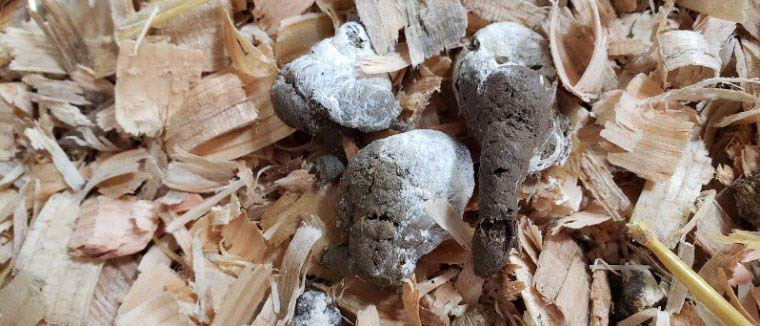
Knowing how much manure to apply depends on how much N, P, and K are in the manure, what crops will be planted, and the nutrient status of the soil, as determined by a soil test. Manure nutrient contents vary by:
- type of animal,
- feeding program,
- amount of bedding mixed in the manure,
- manure age and prior storage, and
- water content of the manure and whether the manure will be incorporated immediately into the soil or not (e.g. tilled into the soil at application or broadcast onto the surface)
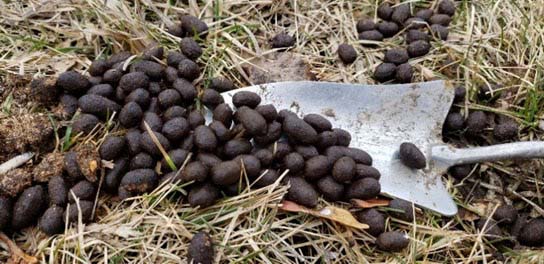
Because manure varies widely and changes with the many factors listed, manure or compost should be tested for the best accuracy. USU’s Analytical Laboratory[BROKEN LINK] tests manure and compost and provides information on proper sample collection and test pricing. To provide an estimate of manure content in Utah, we analyzed all of the manure samples sent to the Utah State University Analytical Laboratory from 2005 – 2019. Table 1 lists the expected N, P, and K contents, pH, salinity, moisture, and C:N ratio.
The timing of the manure application is also important to consider because not all of the nutrients, particularly N, are available for plants to use right away. N in animal manures comes in both organic and inorganic forms. The organic form can be thought of as a ‘slow release’ fertilizer - gradually decomposing and providing plant-available N over time, whereas the inorganic forms are readily available for plant use. Because of this, N from manure should be credited up to three years after an application. When considering the total amount of N in manure, approximately half of N will be available during the first year if the manure is immediately incorporated into the soil. When manure is left on the soil surface, only about 30% of N in manure may be available to plants in the first year. In the second year, about 10% of the remaining nitrogen is available, and about 5% is available in the third year.
On the other hand, most P and K in manure are available to the crop in the first year. It is important to note that in most cases, manure contains more P and K than is removed by crops and not enough N. Therefore, if the manure is applied at a rate that meets crop N needs, soil P and K can become excessively high. As mentioned before, too much P is considered an environmental hazard and too much K needlessly increases soil salinity, which can be costly to correct later on.
The best practice to avoid this issue is to apply manure to meet the P needs of the crop. If the manure application does not supply enough N, you will need to supplement with a high N, low P and K fertilizer or amendments (for example: urea, blood meal, feather meal, fish emulsion, etc.); rotate with legume crops (beans, peas); or plant leguminous cover crops
(birdsfoot trefoil, hairy vetch, medics). The worksheet at the end of this article is a step-by-step guide that helps determine how much manure can be sustainably added to your soil and whether additional N will be needed. This article has a companion fillable workbook that will automatically calculate sustainable rates for your soil.
Composting Manure before Application
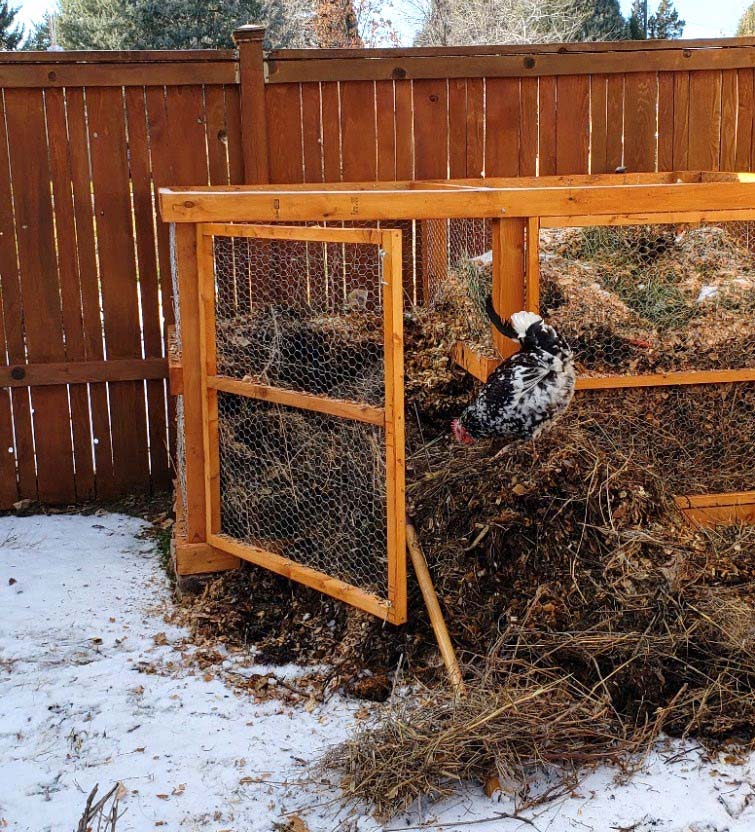
Another option for sustainable animal manure use is to first compost the manure. Composted manure can be one of the best sources of organic matter for your soil. Manure will compost quickly when the compost is frequently turned, adequate moisture levels are maintained, and other compostable materials are added. See USU’s composting fact sheet for more information on composting techniques. The benefits of composting manure include: reduced potential to burn crops, reduced odor and flies, the ability to quickly process other garden and farm wastes (such as weeds, raw food scraps, leaf litter, non-sand bedding), and reduced manure volume (by 20-40%) that simplifies transportation and incorporation.
Composting manure prior to application can also serve as an effective storage method, allowing you to have full control of optimally timing applications to the soil. When composting manure, it is important to keep in mind that some N will be lost in the composting process, whereas P and K generally remain. Also, as composting consolidates the material, the pH and salinity of manure-based composts can be greater in the finished product. This must be a consideration when applying compost to soils, as compost can contribute to excessively high soil salinity levels. Plant-based composts, and composts that exclude urine, tend to be lower-salt options.
As a general rule of thumb, about 1 inch of compost can be sustainably added to most Utah soils each year. More may be added depending on your compost source and soil test. Reduce compost use, particularly manure-derived compost, if your soil test shows elevated levels of P, K, and salinity. Here, we provide an estimate of Utah compost characteristics based on analysis of compost samples sent to the Utah State University Analytical Laboratory from 2005 – 2019. Table 2 lists the expected N, P, and K contents, pH, salinity, moisture content, and C:N ratio.

Sustainability Considerations
Incorporating manures and composts into gardens and agricultural fields reduces waste, recycles nutrients back on the landscape, and can improve soil health. When homeowners or growers do not raise animals, manure or compost can usually be locally sourced. Long-term, sustainable applications of manure and manure-based composts depend on the soil fertility levels of a garden or field through a soil test, as well as understanding the nutrient, pH, and salinity levels of the manure or compost to be applied. Over-application can lead to excess nutrients that reduce crop growth, contaminate water sources, and create soil salinity issues that are difficult or costly to reclaim. You may have noticed that cat and dog manure and composts were not listed. Those manures should be discarded in the trash. Adding cat or dog manure to the garden or compost attracts undesirable animals (raccoons, rats, mice, snakes), elevates the risk of pathogen exposure, and readily releases bad odors during decomposition.
Table 2. Average compost characteristics. The nutrient contents are expressed as percent Nitrogen (N), Phosphate (P2O5), and Potash (K2O). The pH, salinity, percent dry matter (%), and C:N are also given. The data were collected from the Utah State University Analytical Laboratory (USUAL) from 2005 – 2019.
| Compost Type |
N | P2O5 | K2O | pH | Salinity [dS/m] |
Moisture Content [%] |
C:N |
|---|---|---|---|---|---|---|---|
| % | |||||||
| Manure-Based | |||||||
| Beef | 1.1 | 0.9 | 1.3 | 8.5 | 4 | 28 | 12 |
| Chicken | 1.4 | 5.8 | 2.8 | 8.2 | 16 | 33 | 17 |
| Dairy | 1.0 | 0.7 | 1.5 | 8.5 | 8 | 39 | 12 |
| Goat | 1.0 | 0.9 | 1.9 | 8.4 | 5 | 54 | 10 |
| Horse | 0.7 | 0.3 | 0.9 | 8.6 | 4 | 37 | 28 |
| Mink | 1.1 | 3.0 | 0.3 | 6.4 | 6 | 41 | 8 |
| Sheep | 1.0 | 1.1 | 1.3 | 8.0 | 3 | 39 | 15 |
| Turkey | 2.2 | 5.3 | 2.2 | 8.2 | 11 | 89 | 10 |
| Other | |||||||
| Biosolids | 1.8 | 1.5 | 0.2 | 6.9 | 5 | 43 | 7 |
| Commercial | 1.3 | 0.9 | 1.0 | 7.8 | 5 | 35 | 17 |
| Municipal | 1.2 | 1.1 | 0.7 | 7.8 | 5 | 38 | 17 |
| Plant-Based | 1.4 | 0.9 | 0.9 | 7.9 | 3 | 33 | 16 |
Conclusion
With mindful application, manure is a great nutrient source with many secondary benefits. Remember to make applications based on P needs to avoid P and K buildup in the soil, and keep in mind that manures also affect soil salinity and pH. The nutrient values provided in Tables 1 and 2 are averages and it is important to recognize that individual sources vary widely. Consider testing any manure or compost you plan to use to know its specific characteristics.
Manure Application Rate Calculation Worksheet
Additional Resources
- Bihn, E.A., M.A. Schermann, A.L. Wxzelaki, G.L. Wall and S.K Amundson. 2014. On-farm decision tree project: Soil amendments –v5. Cornell CALS. https://gaps.cornell.edu/educational-materials/decision-trees/soil-amendments/
- Cardon, G. E. (n.d.) Fertilizers. Chapter 4 in USU Extension Master Gardener Manual. P 4-1 to 4-10. https://extension.usu.edu/mastergardener/oufiles/chapter4.pdf
- Davis, J., R. Koenig and R. Flynn. 1999. Manure Best Management Practices: A Practical Guide for Dairies in Colorado, Utah and New Mexico. AGWM-04 https://digitalcommons.usu.edu/cgi/viewcontent.c gi?article=1049&context=extension_histall
- Farrell-Poe, K., J. Barnhill, R. Koenig, and B. Miller. 1997. Using Compost in Utah Gardens. https://digitalcommons.usu.edu/cgi/viewcontent.c gi?referer=https://www.google.com/&httpsredir=1 &article=1491&context=extension_curall
- Laboski, C.A.M. and J.B. Peters. 2012. Nutrient application guidelines for field, vegetable and fruit crops in Wisconsin. Chapter 6: Nitrogen. p. 50. University of Wisconsin. https:// www.rockriverlab.com/file_open.php?id=123
- NRSC. 2008. Agricultural Waste Management Field Handbook. Chapter 4: Agricultural Waste Characteristics. p. 4-5. United States Department of Agriculture, Natural Resources Conservation Service Part 651. https://directives.sc.egov.usda.gov/OpenNonWeb Content.aspx?content=31475.wba
- USDA’s National Organic Program. 2018. National Organic Program. https://www.ams.usda.gov/
- University of California, Inyo-Mono Master Gardener Program. How to Calculate the Carbon-toNitrogen Ratio of Your Compost Mix. https:/ /ucanr.edu/sites/mginyomono/files/170818.pdf
Utah State University Extension
Peer-reviewed fact sheet
Download PDF
Authors
Melanie Stock, Tiffany Maughan, and Rhonda Miller
Related Research




